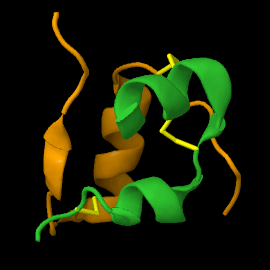Insulin is a hormone made by the pancreas in the body that controls the glucose level in the blood.

Insulin promotes the absorption of sugar from the blood. The sugar is stored as fat cells. People who cannot make insulin in their bodies, or enough for their needs, have the disease diabetes.
When blood glucose levels fall below a certain level, the human body begins to use stored sugar as an energy source through glycogenolysis. This process breaks down the glycogen stored in the liver and muscles into glucose which can then be used as an energy source. Insulin is a central metabolic control mechanism. Insulin is also used as a control signal to other body systems (such as amino acid uptake by body cells). In addition, it has several other anabolic effects throughout the body.
Human insulin is a peptide hormone composed of 51 amino acids and has a molecular weight of 5808 Da. The islets of Langerhans in the pancreas produces insulin. The name comes from the Latin insula for "island". Insulin's structure varies slightly between species of animals. Porcine insulin is especially close to the human version. So, people with diabetes can take in insulin got from pigs instead of producing their own insulin.
History
changeNicolae Paulescu, a Romanian professor of physiology was the first to isolate insulin. He did that in 1916. He called it pancrein. He isolated it by developing a pancreatic extract which, when injected into a diabetic dog, proved to have a normalizing effect on blood sugar levels. He had to interrupt his experiments because of World War I. In early 1921 he wrote four papers about his work carried out in Bucharest and his tests on a diabetic dog. Later that year, he published an extensive paper on the effect of the pancreatic extract injected into a diabetic animal. The title was: "Research on the Role of the Pancreas in Food Assimilation", published 22 June 1921 by the "Archives Internationales de Physiologie",[1][2]
Frederick Banting did similar experiments while trying to find a cure for diabetes. In these experiments he also used dogs. He first knew insulin would control diabetes in a person when he injected some insulin into a 14-year-old boy named Leonard Thompson, who was dying of diabetes.[3] After the injection he survived. Banting won the 1923 Nobel Prize in Physiology or Medicine, with John Macleod, for the discovery of insulin.
The first genetically engineered, synthetic "human" insulin was produced in a laboratory in 1977 by Herbert Boyer using E. coli.[4][5]
Related pages
changeReferences
change- ↑ Paulesco, N.C. (August 31, 1921), "Recherche sur le rôle du pancréas dans l'assimilation nutritive.", Archives Internationales de Physiologie, 17: 85–103
- ↑ Lestradet, H. (1997), "Le 75e anniversaire de la découverte de l'insuline.", Diabetes & Metabolism, 23 (1): 112
- ↑ "Leonard Thompson Biography". dLife. Archived from the original on 2009-02-10. Retrieved 2009-10-06.
- ↑ "First Successful Laboratory Production of Human Insulin Announced". News Release. Genentech. 1978-09-06. Retrieved 2009-11-03.
- ↑ Tof I (1994). "Recombinant DNA technology in the synthesis of human insulin". Little Tree Publishing. Retrieved 2009-11-03.